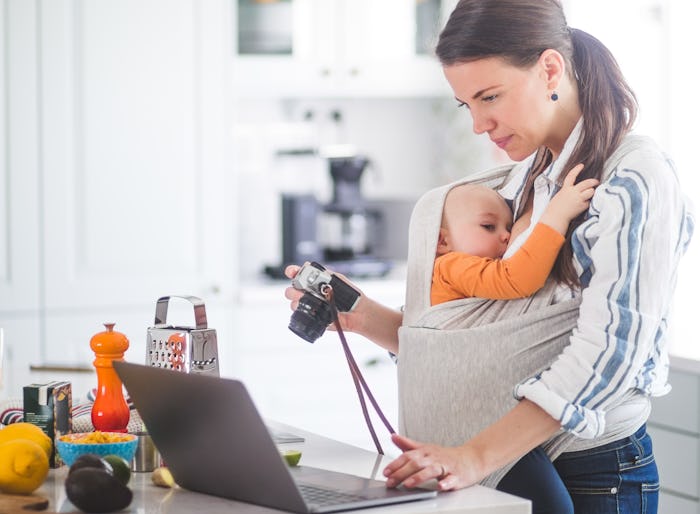Life

Here's The Trick To Breastfeeding Baby While They're In A Carrier
No matter how well you structure your schedule to have breastfeeding sessions at home, there are bound to be times when your little nugget needs to nurse when you’re outside. Thing is, if your child is already snug as a bug in their Snugli, there’s no real reason to have to take them out of the carrier for a feeding. In fact, breastfeeding in a baby carrier can be quite easy, even when you’re on the go — and (woot), there might not be any burping required.
“Breastfeeding in a baby carrier is a great way to multi-task," Darcy Sauers, a postpartum doula and lactation counselor, tells Romper via email. “Plus, all the extra skin-to-skin time is great for helping to produce all the hormones necessary for establishing a good milk supply.” And you don't even need to be seated to successfully nurse in a carrier. "Some moms can feed while vacuuming, making dinner, or even going for a walk," Liza Janda, a certified lactation educator counselor, tells Romper in an email interview. For babies who might be lacking neck control, you'll need to support your baby's head with either your arm or hand. "With a newborn, it's never hands-free breastfeeding for at least the first three months," says Janda.
But before you pop your pint-sized companion in their carrier and head out the door, you should already have breastfeeding basics already down pat. “Before you can master breastfeeding in a baby carrier, the breastfeeding relationship should be well-established,” says Janda. After all, you don’t want to be stuck in the middle of the mall, with a screaming (and starving) baby, and fumbling to get your little cutie out of their carrier. Although this process could take some time, just be patient. “You will probably need to practice wearing the baby and getting comfortable before you try to breastfeed while baby wearing,” she says.
But just because your baby is in the carrier, it doesn’t mean that nursing will be a snap. You’ll need to ensure that both you and your little one are in the right positions to pull off an on-the-go breastfeeding session. "A baby's head should always be 'visible and kissable' in a carrier so that mom can be close enough to see the baby and hear their breathing," says Sauers. But when it comes to nursing, "the baby should be positioned at the breast for feeding, so technically they won't be kissable but you should be monitoring the feeding as well as the breathing," she says.
“Your baby’s ears, shoulders, and hips should be in alignment with each other,” adds Janda. While you and your baby are tummy to tummy, “support your baby’s neck with your hand, and angle the baby’s head back slightly,” she says. This will help create a better latch, since your baby’s chin will come into contact with your breast first, thereby opening their mouth wide for latching. "What you want to always avoid is the baby sinking down low in the carrier and falling asleep with poor air circulation," Sauers advises.
You can expect a breastfeeding session that occurs in a carrier to last just as long as it would if you were home. “In a carrier, your baby should nurse at each breast for as long as they usually do in a regular nursing session,” says Sauers. Andrea Tran, RN, a nurse and lactation counselor, agrees, telling Romper in an email: “Babies should be allowed to feed at the first breast until they come off on their own or they are swallowing infrequently.” Still, there might be times when your child wants a quick comforting nursing session, especially if they are startled awake, or are in a loud or busy place.
Although it might take some time to get used to nursing your baby in a carrier, it does come with one big benefit — no more burping (well, almost). “You only need to take the baby out of the carrier to burp if you know you have a baby that needs that,” says Janda. “Most babies, especially if you are feeding in an upright position in a carrier, can be burped right in the carrier.”
Life doesn’t stop once your little one comes along. (In fact, it gets a lot, lot busier). And while it might be more pleasant to breastfeed your baby from your home, breastfeeding in a carrier can help you feed your child while still getting things done. That way, you can go about your business — all the while safely breastfeeding your baby.
Sources:
Darcy Sauers, a postpartum doula and lactation counselor
Liza Janda, a certified lactation educator counselor
Andrea Tran, RN, a nurse and lactation counselor
This article was originally published on